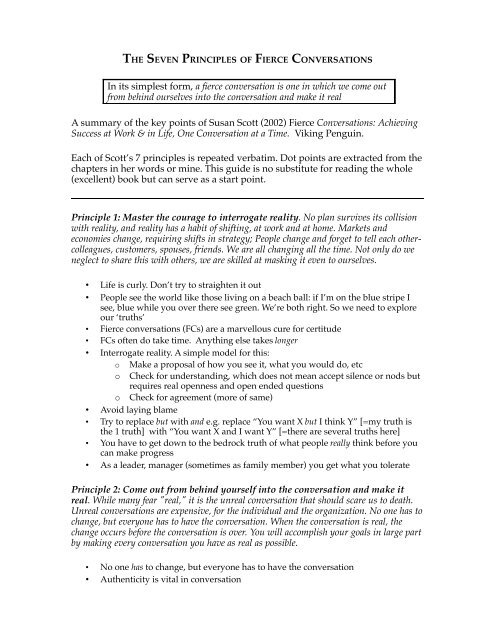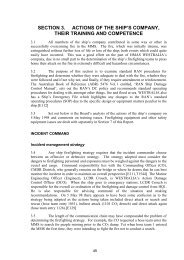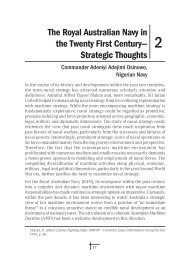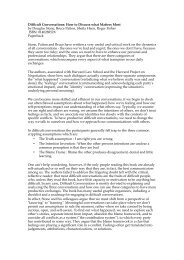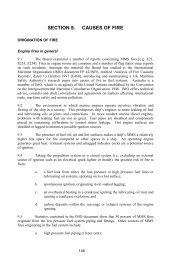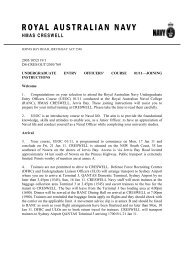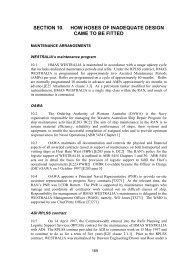THE SEVEN PRINCIPLES OF FIERCE CONVERSATIONS
THE SEVEN PRINCIPLES OF FIERCE CONVERSATIONS
THE SEVEN PRINCIPLES OF FIERCE CONVERSATIONS
You also want an ePaper? Increase the reach of your titles
YUMPU automatically turns print PDFs into web optimized ePapers that Google loves.
<strong>THE</strong> <strong>SEVEN</strong> <strong>PRINCIPLES</strong> <strong>OF</strong> <strong>FIERCE</strong> <strong>CONVERSATIONS</strong><br />
In its simplest form, a fierce conversation is one in which we come out<br />
from behind ourselves into the conversation and make it real<br />
A summary of the key points of Susan Scott (2002) Fierce Conversations: Achieving<br />
Success at Work & in Life, One Conversation at a Time. Viking Penguin.<br />
Each of Scott’s 7 principles is repeated verbatim. Dot points are extracted from the<br />
chapters in her words or mine. This guide is no substitute for reading the whole<br />
(excellent) book but can serve as a start point.<br />
Principle 1: Master the courage to interrogate reality. No plan survives its collision<br />
with reality, and reality has a habit of shifting, at work and at home. Markets and<br />
economies change, requiring shifts in strategy; People change and forget to tell each othercolleagues,<br />
customers, spouses, friends. We are all changing all the time. Not only do we<br />
neglect to share this with others, we are skilled at masking it even to ourselves.<br />
• Life is curly. Don’t try to straighten it out<br />
• People see the world like those living on a beach ball: if I’m on the blue stripe I<br />
see, blue while you over there see green. We’re both right. So we need to explore<br />
our ‘truths’<br />
• Fierce conversations (FCs) are a marvellous cure for certitude<br />
• FCs often do take time. Anything else takes longer<br />
• Interrogate reality. A simple model for this:<br />
o Make a proposal of how you see it, what you would do, etc<br />
o Check for understanding, which does not mean accept silence or nods but<br />
requires real openness and open ended questions<br />
o Check for agreement (more of same)<br />
• Avoid laying blame<br />
• Try to replace but with and e.g. replace “You want X but I think Y” [=my truth is<br />
the 1 truth] with “You want X and I want Y” [=there are several truths here]<br />
• You have to get down to the bedrock truth of what people really think before you<br />
can make progress<br />
• As a leader, manager (sometimes as family member) you get what you tolerate<br />
Principle 2: Come out from behind yourself into the conversation and make it<br />
real. While many fear "real," it is the unreal conversation that should scare us to death.<br />
Unreal conversations are expensive, for the individual and the organization. No one has to<br />
change, but everyone has to have the conversation. When the conversation is real, the<br />
change occurs before the conversation is over. You will accomplish your goals in large part<br />
by making every conversation you have as real as possible.<br />
• No one has to change, but everyone has to have the conversation<br />
• Authenticity is vital in conversation
• Authenticity is not something you have: it is something you choose [By extension,<br />
to paraphrase Aristotle “we are what we habitually do. Authenticity then is not an<br />
act but a habit.”]<br />
• In our life, we often pretend not to know things. What are you pretending not to<br />
know about your life, your work, your relationships?<br />
• Successful relationships require that all parties view getting their core needs met<br />
as legitimate—it is not selfish but healthy to expect yours to be met as well as<br />
other’s<br />
• Authenticity is a powerful attractor. When we free our true selves we release<br />
energy. Others recognize and respond to this<br />
• We need to be open to change. If we think we have a core, fixed identity that<br />
cannot change, we cannot be open to a real FC<br />
• The truth will set you free, but it may irritate you first<br />
• Take things personally and takes things seriously. Ignore those platitudes to the<br />
contrary, because this life is the only one you get and there needs to be enough<br />
‘you’ here to make something of it<br />
Principle 3: Be here, prepared to be nowhere else. Our work, our relationships, and<br />
our lives succeed or fail one conversation at a time. While no single conversation is guar-<br />
anteed to transform a company, a relationship, or a life, any single conversation can.<br />
Speak and listen as if this is the most important conversation you will ever have with this<br />
person. It could be. Participate as if it matters. It does.<br />
• Being really understood is a moving experience. It will move you and you have<br />
the opportunity to move others<br />
• Cynicism and prejudice get in the way both of trying to understand another fully<br />
and in the way of succeeding<br />
• If you live in a world of routine platitudes (“Hi, how are you?” “Fine”) for long<br />
enough, you and your relationships will be a shell<br />
• But often we close off into platitudes because we are scared of reality<br />
• Ask others what they think is important to talk about: if they say X is, it is, even it<br />
doesn’t look important to you at first. Deny that importance, kill the conversation<br />
• When you listen, really listen and listen for content, feelings and intentions and for<br />
what is not said<br />
• The common mistakes in 1 on 1 conversations (esp. if you are the ‘boss’) are:<br />
o Doing most of the talking<br />
o Taking the problem away from the other<br />
o Not inquiring about feelings<br />
o Delivering unclear messages, unclear coaching or unclear instructions<br />
o Cancelling a meeting for a planned conversation 1 on 1 (short of death—<br />
yours!—this communicates disrespect)<br />
o Allowing interruptions<br />
o Running our of time<br />
o Assuming, without checking, that the conversation is effective<br />
• The great rule: Ask not tell. Keep asking as much as possible until you are sure<br />
you really understand [cf. Covey: “seek first to understand then be understood”.]
Principle 4: Tackle your toughest challenge today. Burnout doesn't occur because<br />
we're solving problems; it occurs because we've been trying to solve the same problem<br />
over and over. The problem named is the problem solved. Identify and then confront the<br />
real obstacles in your path. Stay current with the people important to your success and<br />
happiness. Travel light, agenda-free.<br />
• Name the problem. Naming the crucial issue that faces you, or helping others to<br />
name their problem, is critical.<br />
• Hold the advice. Faster than a speeding bullet, a problem named by X generates a<br />
solution offered by Y [“Premature convergent thinking”.] Divergent thinking<br />
takes time but may yield a better answer and anyway it is best to help X find a<br />
solution they own and believe in….]<br />
• Get the undiscussables on the table: don’t collude in the “I won’t mention your<br />
problem if you don’t mention mine” game<br />
• If you fear the confrontation of mentioning undiscussables, then ‘feel the fear and<br />
do it anyway’, remembering that all the bad outcomes you fear will likely come<br />
back to haunt you if don’t confront<br />
• Confrontation is not about establishing your ‘truth’. It is about stating your view<br />
and exploring how others see it and how they react to your view<br />
• How not to have a conversation in which you raise a difficult issue:<br />
1. The pseudo innocent “How’s it going?” You don’t want to know, I know<br />
that, why don’t we get real? Even better, I’ll tell you how fabulously it is<br />
going. Now what will you say?<br />
2. The Oreo cookie (in Aus, ‘the shit sandwich’): slipping negative news in<br />
between praise. Which bit shall I pay attention to? People deserve better.<br />
3. Too many pillows: dropping gentle hints into a soft conversation, hoping<br />
the other will get it. Likely they won’t and everyone will be frustrated.<br />
4. Writing the script: assuming you know what will be said and why, so<br />
much that when they don’t, we still carry on down that track, or even<br />
angrily pre-empt what they weren’t going to say…<br />
5. Machine gun: letting stuff build up until the one point you really need to<br />
make is simply part of a rapid blast of complaints, accusations, etc.<br />
• The right way A: general principles:<br />
1. Clearly and succinctly advocate what your position is.<br />
2. Illustrate your position and share your thinking.<br />
3. Publicly test your views and encourage others to do so too.<br />
4. Inquire into the views of others and explore their thinking.<br />
• The right way B: steps to open up:<br />
1. Name the issue.<br />
2. Give a specific example.<br />
3. Describe your emotions.<br />
4. Clarify what you see at stake.<br />
5. Identify your contribution (e.g. “I should have raised this sooner”, “I think<br />
I was not paying close attention”, “I have been reluctant to be honest with<br />
you”, whatever).<br />
6. Indicate your desire to resolve the problem.
7. Invite your partner to respond.<br />
• All conversations are primarily with yourself: others sometimes get to play a role.<br />
• If something must change, you surely will need to be part of the change.<br />
• In interaction with the other, hold to maintaining the central purpose and keeping<br />
conversation going.<br />
• Focus on results (a win/win outcome we both value), not on ‘reasons’ (principles<br />
we can die in a ditch with).<br />
Principle 5: Obey your instincts. Don't just trust your instincts—obey them. Your<br />
radar screen works perfectly. It's the operator who is in question. An intelligence agent is<br />
sending you messages every day, all day. Tune in. Pay attention. Share these thoughts<br />
with others. What we label as illusion is the scent of something real coming close.<br />
• Pay attention to what you feel, to what you think but have not said.<br />
• Look beneath the surface—yours and other’s—don’t just stay with the literal<br />
words.<br />
• When you feel lost in a conversation, chances are you have not been looking<br />
beneath the surface.<br />
• If your instincts are telling you something, take them seriously. If you suppress<br />
them through fear you will probably miss something vital.<br />
• A careful conversation is usually a failed conversation.<br />
Principle 6: Take responsibility for your emotional wake. For a leader, there is no<br />
trivial comment. Something you don't remember saying may have had a devastating<br />
impact on some- one who looked to you for guidance and approval. The conversation is not<br />
about the relationship; the conversation is the relationship. Learning to deliver the<br />
message without the load allows you to speak with clarity, conviction, and compassion.<br />
• What do you leave behind you in your wake? It is your responsibility to know<br />
and to act mindfully of this, esp. if you are a leader.<br />
• In whose wake are you left floundering? Do you want to be in a relationship with<br />
that person?<br />
• Who needs to hear from you? What messages do they need to hear?<br />
• Make the implicit, explicit: if you love someone say so, they may not know<br />
otherwise.<br />
• The conversation is not about the relationship, it is the relationship.<br />
• Make important messages unmistakable, don’t water down from fear and then<br />
find yourself misunderstood (this does not mean ‘be abusive’!).<br />
• Aim for the chopping block: when you chop wood, you aim not at the log but at<br />
the block. Like karate, you hit ‘through’. Conversations are like this, aim ‘through’<br />
to where you need to be.<br />
• Do not start “Let me be frank/honest…” etc. What are you usually, then? Just be<br />
frank, honest, whatever.<br />
• Use the word ‘no’ when relevant. Sometimes ‘no’ is not a problem, it is a solution<br />
• When the going is tough, make it your goal to hold the conversation in a place<br />
that is truthful and safe.
• Hang in there; finish the conversation.<br />
• Don’t lie. A few white lies are OK, but the core principle is truth. If truth looks<br />
hurtful and no useful purpose is served by brutal honesty, ask “what would be<br />
the loving thing to do?” Then, maybe, the odd white lie will be justified.<br />
Principle 7: Let silence do the heavy lifting. When there is simply a whole lot of<br />
talking going on, conversations can be so empty of meaning they crackle. Memorable<br />
conversations include breathing space. Slow down the conversation, so that insight can<br />
occur in the space between words and you can discover what the conversation really<br />
wants and needs to be about.<br />
• Without moments of silence there is no reflection and no space for thoughts to<br />
develop and mature: aim for silences some of the time and be comfortable with<br />
them.<br />
• Here are signs that you need to use silence more:<br />
o You interrupt and talk over people.<br />
o You are formulating your own response while s/he is talking.<br />
o You respond instantly, without reflection.<br />
o You try to look clever, charming, impressive, etc.<br />
o You jump in with advice before the issue has been clarified.<br />
o You colonise silences to break the conversation or change direction.<br />
o You talk in circles and nothing new is emerging.<br />
o You monopolise the airspace.<br />
• Slow down, hear yourself breathe, breathing is good.<br />
• There are insights and emotions you can find only through silence.<br />
• Never mistake talking for conversation.<br />
• Silence is not automatically good: the silence of passive, covert aggression is bad.<br />
• Use silence to become more mindful and self aware, be happy to keep yourself<br />
company.<br />
• Take the risk to engage along these lines:<br />
I will be known<br />
I will be seen<br />
I will be changed<br />
*****************************************************************************************************


